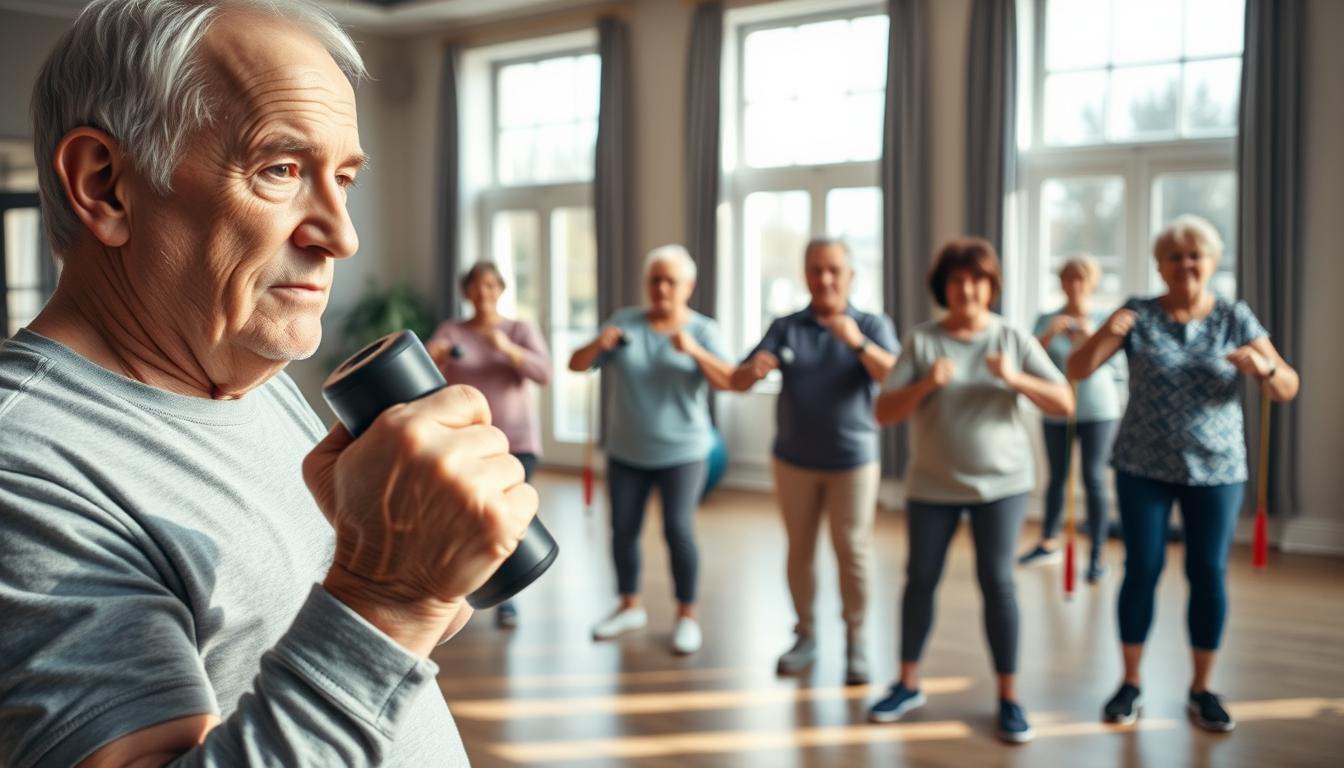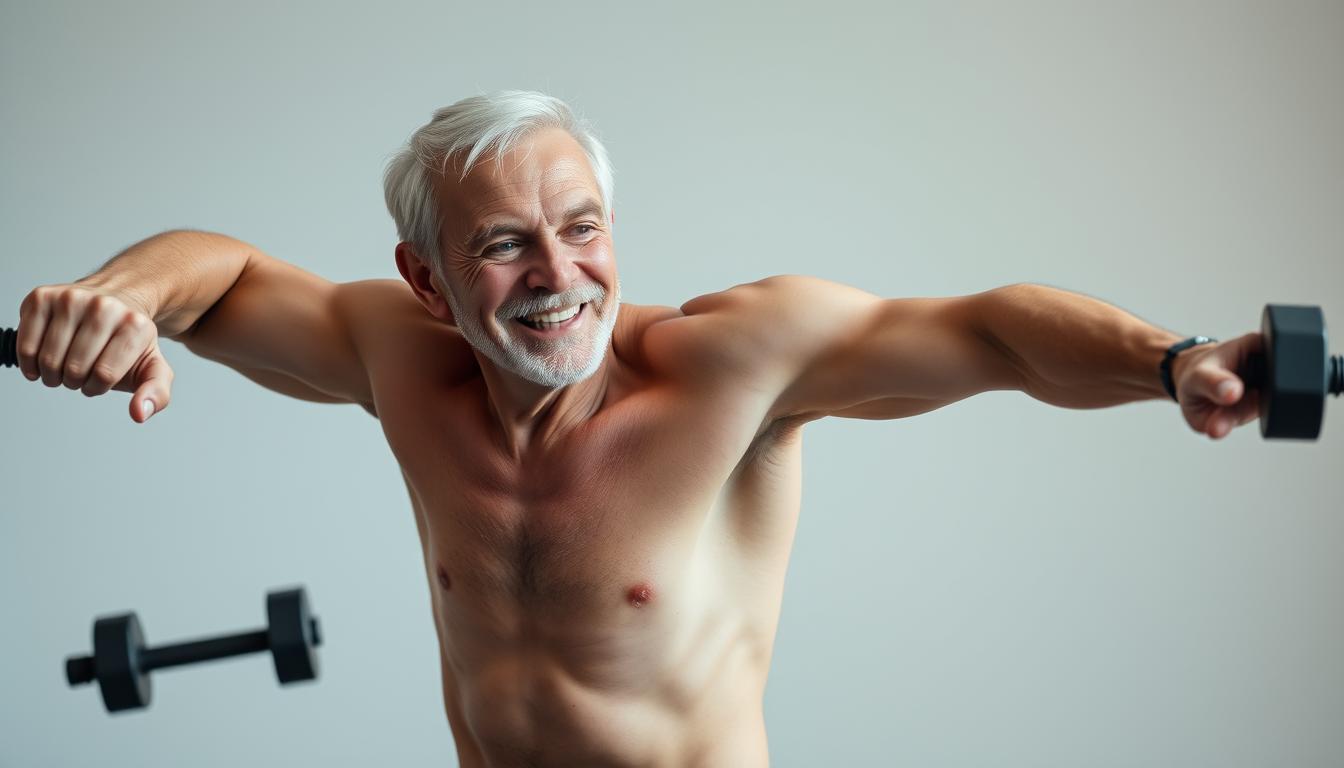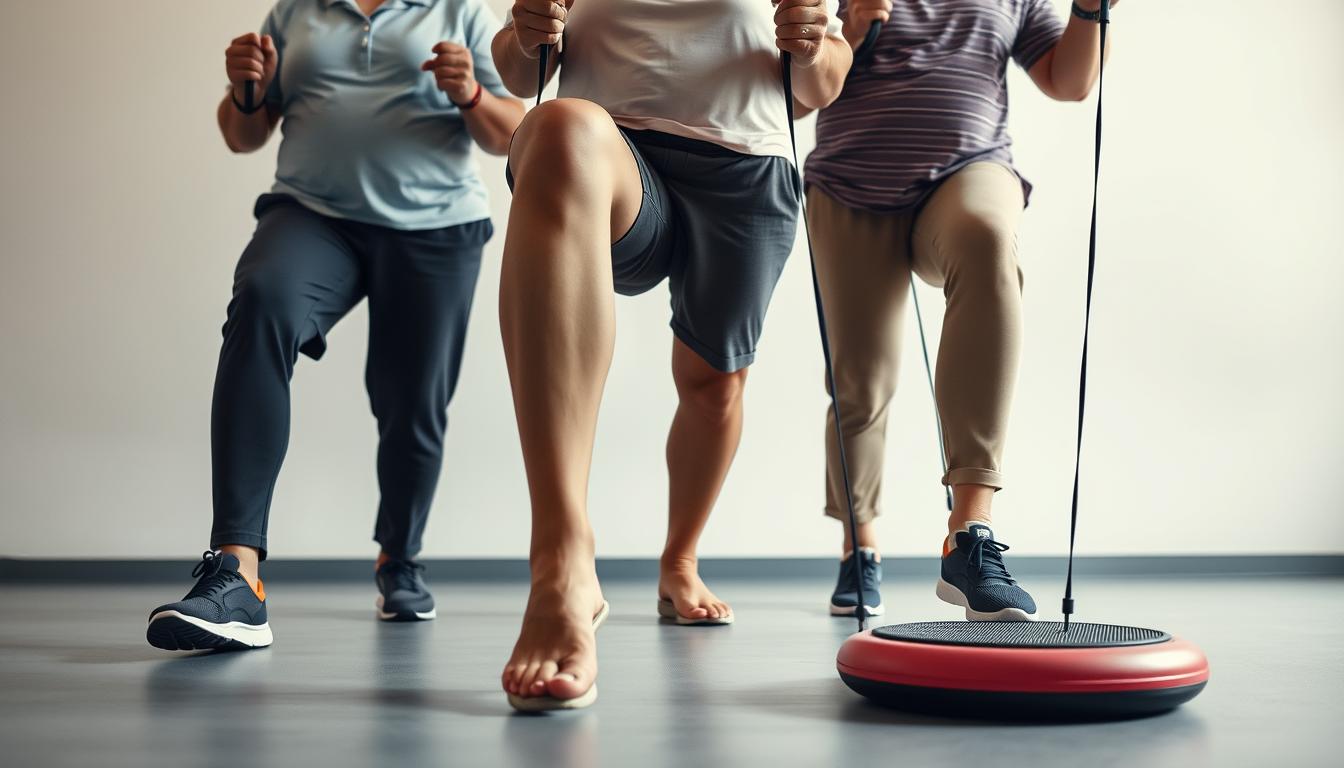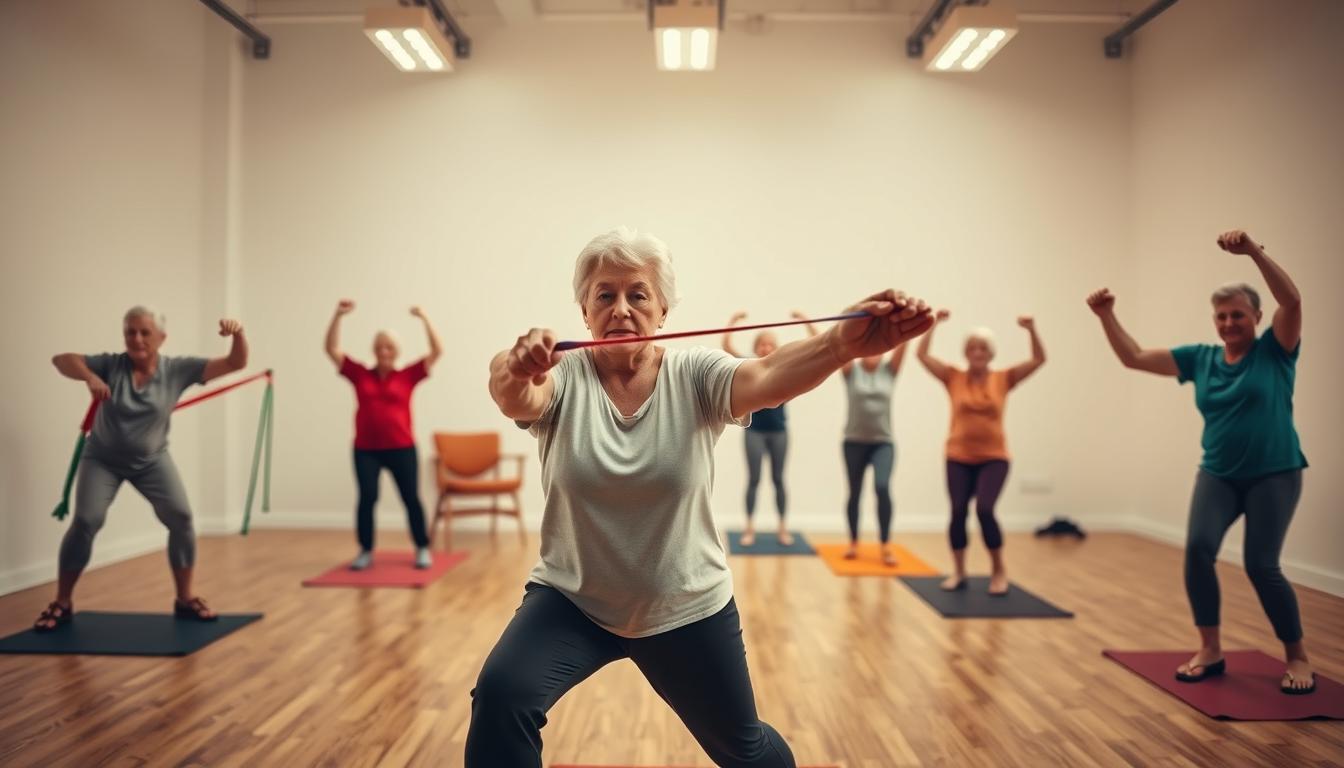Want to build muscle without leaving your couch? You bet. I’ve spent years testing routines that turn coffee tables into workout gear—and trust me, your living room’s about to become way more interesting than any gym.
Take calf raises while brushing your teeth. Planks during commercial breaks. Chair squats using—you guessed it—that sturdy dining chair collecting dust. These aren’t just moves; they’re life hacks for staying mobile, whether you’re 65 or 85.
I’ll show you how wall angels can fix posture better than a chiropractor’s invoice. Or why elevated pushups (yes, against the kitchen counter) beat grunting on gym floors. No fancy equipment. No sweaty strangers. Just real results from stuff you already own.
Curious how a resistance band and canned beans can out-lift dumbbells? Stick around. We’re flipping “exercise” into something that fits between Jeopardy! and bedtime tea.
Overview and Getting Started

Ever wonder why your favorite jeans feel looser each year? Blame it on sarcopenia—your muscles’ sneaky retreat. Starting around 50, we lose 1-2% of muscle mass annually. No kidding. But here’s the kicker: your couch can become a battleground against this silent thief.
Why Your Muscles Need a New Playbook
I once watched a client transform her dining chair into a total-body tool. She’d grip the backrest for balance during leg lifts, then flip around for tricep dips. Genius, right? That’s the power of understanding your body’s shifting needs. Mobility isn’t about flexibility—it’s about reclaiming control over how you sit, stand, and reach for the top shelf.
Your Living Room Gym Blueprint
Clear a 4×4 foot space—that’s your movement zone. Place a sturdy chair (no wheeled office types!) near a wall for support. See that coffee table? Perfect for elevated pushups. I’ve seen folks use canned goods as weights and bath towels as sliders. Give it a whirl: try 10 chair squats while waiting for the microwave. Your future self will high-five you.
Pro tip: Mark your workout area with tape. It creates mental boundaries—like your personal “do something awesome here” zone. And always? Feet flat, back straight, eyes forward. Posture matters more than reps when you’re building lasting strength.
Warm-Up Routines and Mobility Tweaks
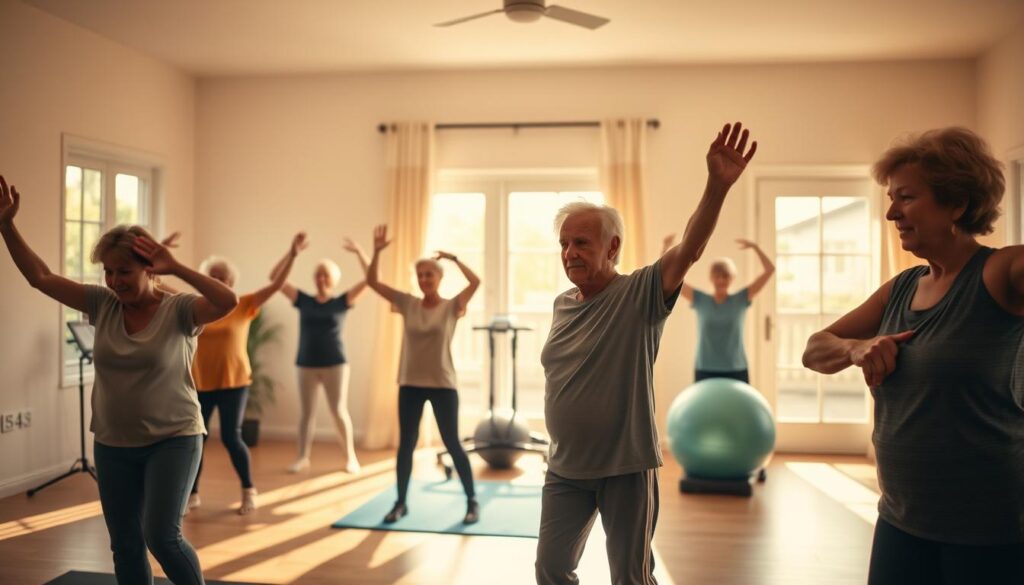
Your joints aren’t rusty hinges—they’re more like vintage sports cars needing premium fuel. Dynamic warm-ups prime your legs, hips, and shoulders for action while keeping things low-impact. Let’s skip the static stretches and dive into moves that actually wake up your body.
Simple Dynamic Stretches for Joint Activation
Start seated on the floor (or a firm couch). Lift your toes 10 times while keeping heels planted—this fires up shin muscles often neglected. Next, stand with feet shoulder-width apart and practice “knee marches”: lift one knee to hip height, then switch. No biggie if you need chair support.
Try torso twists while brushing your teeth. Reach arms out wide, rotate slowly left to right. You’ll feel your core engage naturally. These aren’t just stretches—they’re body language for “Hey joints, we’ve got work to do!”
Quick Mobility Drills That Make a Difference
Grab a wall for balance drills. Shift weight to one leg, lift the other knee slightly. Hold 5 seconds, switch sides. Want more challenge? Try tracing alphabet letters with your lifted foot—A through E works wonders.
Finish with hip circles: hands on hips, make slow clockwise motions. Reverse after 8 reps. Pro tip: Balance improves fastest when you practice off-balance positions safely. And always? Keep those knees tracking over toes during any squat-like moves.
Best Strength Training Exercises for Seniors at Home
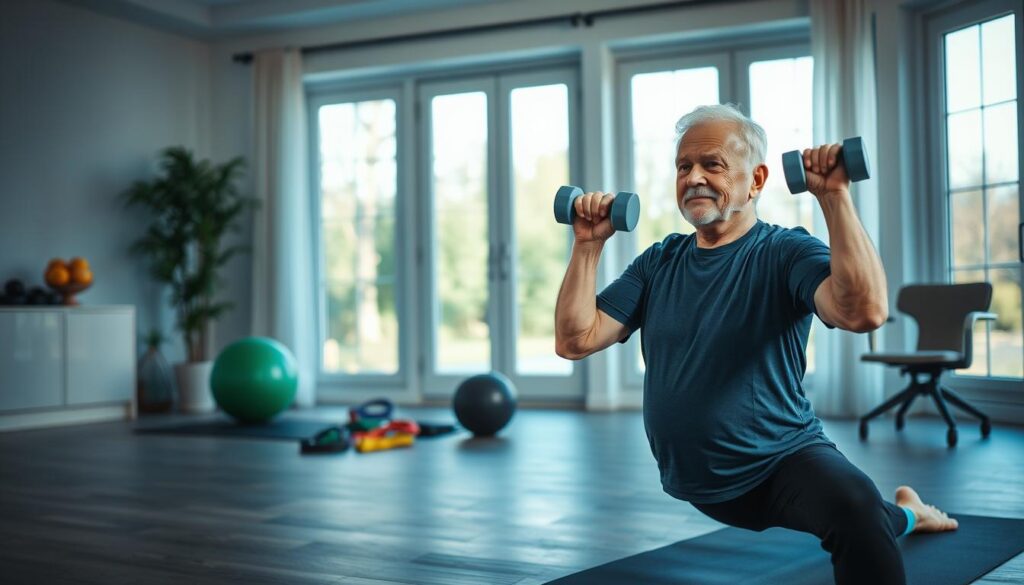
Let’s cut to the chase—your next workout is hiding in plain sight. These four moves use walls, floors, and that trusty chair you’ve been eyeing. Trust me, your muscles won’t know what hit them.
Calf Raises & Modified Planks
Toe-powered lifts first: Stand facing forward, feet shoulder-width. Push through your toes to rise onto balls of your feet. Lower slowly—15 reps. You’ll feel those calves sing by rep 10. Pro tip: Use the wall for balance if needed.
Now for planks: Elbows under shoulders, forearms flat. Keep your back straight and core tight. Hold 15-20 seconds. Too tough? Drop knees to the ground. Too easy? Lift one leg an inch. You know the drill.
Elevated Pushups & Wall Angels
Find a blank wall space. Place palms at chest height, step back until arms straight. Bend elbows to lean in—controlled movement is key. Do 8-10 reps. Your arms and chest will thank you later.
Wall angels? Stand back-to-wall, feet 6 inches out. Press palms against the surface, slide arms up overhead while keeping contact. Return slowly. This posture fixer doubles as a shoulder opener. No chiropractor required.
| Exercise | Reps/Time | Focus Area | Pro Tip |
|---|---|---|---|
| Calf Raises | 15 reps | Lower Legs | Use counter for balance |
| Modified Planks | 15-20 sec holds | Core Stability | Adjust knee position |
| Elevated Pushups | 8-10 reps | Upper Body | Control tempo |
| Wall Angels | 10 reps | Posture | Maintain wall contact |
Alignment matters more than speed here. Keep shoulders down, knees over toes, and breathe steady. These moves aren’t about brute force—they’re precision tools for building lasting mobility. Your living room just became smarter than any gym.
Chair Squats and Functional Movement Fundamentals

That sturdy dining chair? It’s about to become your new best friend for mastering one of life’s most essential moves. I’ve taught hundreds how to turn sitting down and standing up into strength-building gold—no fuss, no muss.
Your Seat’s Secret Superpower
Here’s the drill: Stand facing away from your chair, feet hip-width. Push your hips back like you’re closing a car door with your behind. Lower slowly until you almost touch the seat—then drive through your legs to rise. Keep your knees aligned over toes, back straight as a librarian’s posture.
Too easy? Try pausing halfway down. Too tough? Use armrests for support. This isn’t just exercise—it’s practice for real-world moves like getting out of your car or off the toilet. Control beats speed every time.
| Focus Area | Common Mistakes | Quick Fixes | Functional Benefit |
|---|---|---|---|
| Legs & Hips | Knees caving inward | Imagine squeezing a ball between knees | Easier stair climbing |
| Core Stability | Rounding the lower back | Engage abs like zipping tight jeans | Better balance when reaching |
| Upper Body | Leaning too far forward | Keep chest lifted, gaze ahead | Stronger grocery bag carrying |
Pro tip: Time your squats with commercial breaks. Three sets of 8-10 reps builds functional strength that translates directly to daily life. Your future self will appreciate every controlled descent.
Nutritional Strategies to Powers Your Workouts

What if your fridge could be your new workout partner? I’ve seen clients boost their health gains by pairing smart movement with even smarter eating. Think of it this way: every rep builds muscle, but what you eat determines whether those gains stick around for the long haul.
Protein-Packed Snacks and Meals
Let’s talk real food. My go-to? Greek yogurt with almonds—it’s like edible Velcro for muscle repair. Hard-boiled eggs work wonders too. Mash one onto whole-grain toast for a quick “I’m adulting” snack. Not into dairy? Try roasted chickpeas—crunchy, salty, and packed with plant-based protein.
Keep it simple: aim for 20-30 grams of protein per meal. A palm-sized chicken breast or half a cup of lentils does the trick. Pair with colorful veggies—your plate should look like a sunset, not a beige cave.
Balancing Nutrients Without a Gym Diet Plan
Forget complicated meal plans. My rule? Eat smart, not strict. Combine lean proteins with fiber-rich carbs (quinoa, sweet potatoes) and healthy fats (avocado, olive oil). This trio keeps energy steady and muscles fed.
Hydration’s your secret weapon too. Sip water between sets—it’s like oil for creaky joints. Pro tip: Add lemon slices or mint leaves to make plain H₂O less boring. Your body’s 60% water—treat it like premium fuel.
Remember: Small tweaks create big benefits. Swap white rice for cauliflower rice once a week. Use herbs instead of salt. Your taste buds—and biceps—will adapt faster than you think.
Practicing Safe Training and Seeking Advice

Safety first isn’t just a slogan—it’s your secret weapon against workout woes. I once coached a spry 72-year-old who thought skipping her doctor’s okay was no big deal. Two weeks later? Let’s just say her grandkids nicknamed her “Wobbly Grammy.” Trust me: a quick chat with your physician beats ice packs and regret.
Insights from Health Pros and Physical Therapists
Your body’s like a custom-tailored suit—it needs adjustments only experts understand. Physical therapists can tweak chair squats if your knees protest, or suggest gentler alternatives when planks feel like medieval torture. It happens to the best of us.
Falls aren’t just slippery floor hazards. They’re sneaky confidence thieves. A seasoned trainer once showed me how shifting weight slightly forward during standing moves creates instant stability. Genius, right? Make sure your setup mirrors this: nonslip shoes, clutter-free zones, and lighting brighter than a detective’s interrogation lamp.
Here’s the real talk: pushing through pain isn’t heroic—it’s how injuries gatecrash your progress. If your shoulder nags during wall angels, scale back. Use a resistance band for support. Your future self will toast your wisdom with extra herbal tea.
Remember: safe training isn’t about limitations. It’s about playing the long game. Because nothing beats outsmarting Father Time with smart moves and smarter advice.
Tracking Progress and Adapting Your Routine
![]()
Progress isn’t about numbers—it’s noticing you can lift the grandkids without wincing. Here’s the scoop: your body’s subtle shifts matter more than any fitness tracker. I’ve seen clients spot breakthroughs in unexpected places, like carrying groceries or reaching for a high shelf.
Monitoring Strength Gains and Balance Improvements
Grab a wall calendar. Circle days you complete your routine. Jot notes like “held plank 5 seconds longer” or “stairs felt easier today.” These breadcrumbs reveal patterns. That slight wobble during calf raises last month? Now you’re steady as a lighthouse.
Balance improvements often show up first in daily life. Maybe you pivot smoother while vacuuming or stand on one leg to put pants on. Core engagement becomes automatic—like your abs finally remembered their job description. Celebrate these wins—they’re proof your workout’s working behind the scenes.
Adjusting Reps and Resistance as You Improve
When chair squats feel like a breeze, shift your position. Try lowering slower, or pause halfway for 3 seconds. For wall angels, move your feet farther from the wall—instant difficulty boost. Resistance bands add spice too: loop one underfoot during bicep curls.
Check your elbows during pushups. Are they flaring out like chicken wings? Tuck them closer to your sides for better form. Small tweaks keep muscles guessing—like tuning a radio dial until the signal clicks. Your future reps will thank you for the thoughtful adjustments.
Remember: progression isn’t linear. Some days you’ll rock 12 reps, others just 8. That’s normal. What matters is showing up, observing changes, and adapting like a fitness detective on the case. Your body’s whispers today become shouts of strength tomorrow.
Wrapping Up with Next Steps for Sustainable Health
Here’s the beautiful truth: your strongest days might still be ahead. Those subtle shifts—reaching higher shelves without wobbling, carrying groceries like they’re feather-light—are the real benefits adding up. I’ve watched clients discover newfound ease in daily tasks simply by tracking how their shoulders sit straighter or their hands grip firmer.
Keep a notebook by your exercise zone. Jot when wall pushups feel lighter or your head stays aligned during planks. These tiny wins compound faster than you’d guess. Mix things up too—try shifting your weight slightly to one side during chair squats, or experiment with different arm angles during counter pushups.
Your front door isn’t just an entrance—it’s a reminder to keep moving forward. Stay tuned—I’m brewing up fresh ways to keep your progress rolling. Until then: check your shoulder positioning often, engage your core like you’re bracing for a hug, and remember—every rep rewrites what’s possible.
